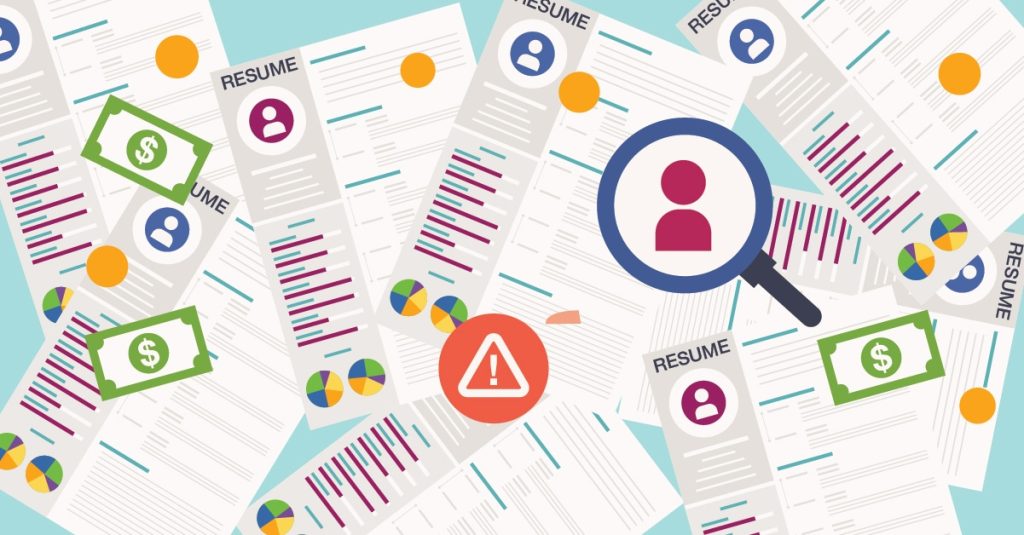-
Nearly three fourths (74 percent) of employers say they’ve hired the wrong person for a position. That’s bad news: Employers have a lot to lose when an employee doesn’t work out.
The hiring process takes an average of 42 days and may involve hours of face-to-face meetings, testing, paperwork, contacting references, and performing background checks. Companies spend an average of $14,900 per bad hire. Want to make sure you hire the right person for your next job opening? Keep reading to discover 10 common red flags to look out during the hiring process.

-
Watch for Warning Signs
Look out for these telling signs that an employee may cost your company more than they bring in.
-
Late arrival
If a person is late for an important appointment, it doesn’t bode well for how prompt they’ll be for work or client meetings. Occasionally, a candidate may have an unavoidable excuse for being late for a job interview. However, more often tardiness may be a sign a person isn’t dependable, disciplined, or respectful.
-
No research of preparation
Do candidates understand your mission statement? Have they read your website? Are they well versed in your products or services? Did they study the job description? Did they bring an extra resume and a pen and paper to take notes? If not, they may not be well prepared on the job either.
-
Vague answers
Ask specific questions during interviews and listen for specific answers. Beware of non-specific phrases, such as “I’m a quick learner” or “I make a lot of sales,” without concrete examples to back them up. Vagueness may be a sign that candidates don’t have as much experience as they’re saying. If someone gives a non-specific answer, rephrase the question and ask again, or follow up by asking, “Can you give an example?”
-
Outright lies
In a survey, 85 percent of employers said they’ve caught someone lying on a resume. Moreover, according to research conducted by the University of Massachusetts, 81 percent of people lie during job interviews. It probably goes without saying but lying during the hiring process indicates someone may not be a trustworthy employee.
Look for these common mistruths:
- Jobs and dates on a resume don’t match information listed on a social media platform
- Skills or positions are invented or embellished
- Past salaries are exaggerated
- Academic degrees or credentials are falsified
- Friends are posing as former bosses or colleagues for references

-
No mention of teamwork
Collaboration is crucial to workplace success. In one study people primed to work collaboratively worked on tasks longer and reported higher engagement rates and lower fatigue levels. Moreover, in another study companies that encouraged collaboration were five times more likely to be high performing. Do job candidates give credit to others when they describe past accomplishments and use the word “we” to explain past projects? If not, they may not work well with others or prioritize teamwork.
-
Complaints about previous bosses or coworkers
Research suggests venting about work makes people unhappier and do worse on the job. It also may be a sign that candidates won’t take responsibility for their own actions and may soon have a list of grievances about you and your company.
-
Unexplained employment gaps
There are plenty of understandable reasons for taking time off between jobs, including family emergencies, caretaking, and continuing education. None of them need to be deal breakers, especially if candidates honed job-specific skills between positions. However, if jobseekers took more than four to six months off between jobs and can’t explain why or how they used the time, it could be a sign they’re hiding something, perhaps a protracted job search or failed business.
-
Lack of enthusiasm
If candidates seem bored at an interview, they may sleepwalk through their work days. That’s a huge problem: Disengaged employees cost U.S. companies between $485 and $605 billion a year. Highly engaged employees are more likely to be highly productive and less likely to leave a company. Hold out for an employee who’s passionate about the position and has shown commitment to past companies.

-
Long commute
People who live closer to work are happier and more likely to stick around. Long commutes are linked to increased absenteeism, frequent tardiness, higher turnover rates, lower employee engagement, increased error rates, worse employee health, lower productivity, and worse performance. The average Americans worker’s commute is 26 minutes. If candidates’ commutes are much longer than that and they have no plans to move closer, you may want to keep looking for the right person.
-
No questions
The interview’s nearly over, and you ask, “Do you have any questions about the position?” Listen carefully. If candidates don’t have any inquiries, they may not be invested in the company or position. If they bombard you with questions about the salary or benefits, they may be more concerned about what’s in it for them than you.
-
Conclusion
Watch out for these common red flags during the hiring process to avoid the wasted time, stress, and money that come with a bad hire. In addition, do background checks, call references, and scroll through candidates’ social media posts to make sure candidates are a good fit for your company.
Increasingly, some companies are moving beyond the typical interview process to get an even better look at applicants’ abilities. A job audition allows employers to watch candidates perform the actual job for a few hours. And a month-long trial period is a great way to evaluate new hires and see how they fit with an existing team. No matter what your hiring process looks like, set clear expectations for new hires and don’t hesitate to break up with employees who aren’t working out.
10 red flags to watch out for when hiring your next employee
- by Kristen Ghergich
- Published on September 17, 2018
- Office Tips



